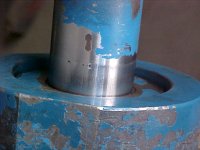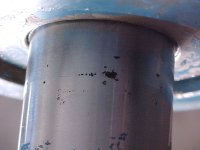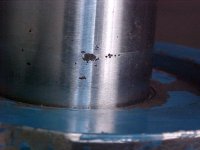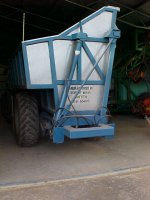allenr
Gold Member
- Joined
- Nov 28, 2006
- Messages
- 398
- Location
- Barossa Valley, South Australia
- Tractor
- Duetz DX3.70, Fendt 305LSA,260S & 205P,Kubota B6100E & 3 x B5100E & RTV900, Caterpillar 428C
Pictured below is the seal and head gland from a 4" Barrel x 2" Rod x 60" Stroke hydraulic cylinder made in Australia by Collier & Miller.
There was a leak between the rod and the head gland so removed the gland seal with an idea of cutting a strip of thin perspex to spring into the seal reccess.
The seal wasn't as rubbery as anticipated and it broke while removing it. Dimensions are 2" ID x 2 1/2" OD x 1/4" wall thickness x 1/4" depth.
Can anybody identify what this type of seal is called - as you might see in the pics it looks a bit like a low pressure lip seal with an o-ring pushed in the gap but it is all one piece.
Appears to me the seal isn't as compliant as it might be and maybe lacks the proper lip to push out under pressure, but having said that I think it leaked worse when standing in the shed under no pressure.
Or is there an altogether better seal which could fill that 1/4 x 1/4" recess.
I've been thinking about a 1/4 x 2" ID x 2 1/2" OD O-ring but you don't often come across such thick O-rings - maybe for good reason?
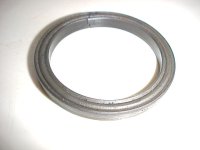
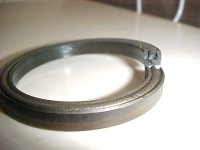

There was a leak between the rod and the head gland so removed the gland seal with an idea of cutting a strip of thin perspex to spring into the seal reccess.
The seal wasn't as rubbery as anticipated and it broke while removing it. Dimensions are 2" ID x 2 1/2" OD x 1/4" wall thickness x 1/4" depth.
Can anybody identify what this type of seal is called - as you might see in the pics it looks a bit like a low pressure lip seal with an o-ring pushed in the gap but it is all one piece.
Appears to me the seal isn't as compliant as it might be and maybe lacks the proper lip to push out under pressure, but having said that I think it leaked worse when standing in the shed under no pressure.
Or is there an altogether better seal which could fill that 1/4 x 1/4" recess.
I've been thinking about a 1/4 x 2" ID x 2 1/2" OD O-ring but you don't often come across such thick O-rings - maybe for good reason?




